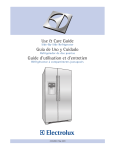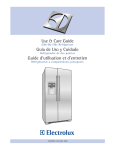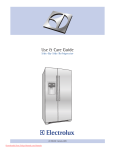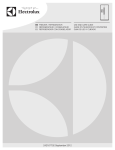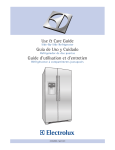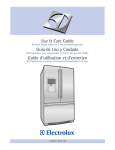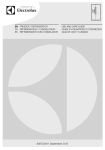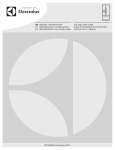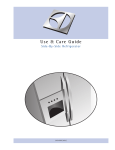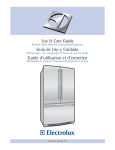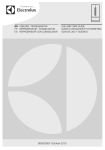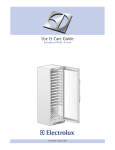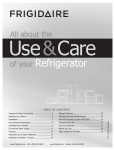Download Electrolux Side by Side Refrigerators Use & care guide
Transcript
Use & Care Guide Side-By-Side Refrigerator 241868900 August 2007 2 Finding Information Please read and save this guide Thank you for choosing Electrolux, our new premium brand in home appliances. This Use & Care Guide is part of our commitment to customer satisfaction and product quality throughout the service life of your new appliance. Keep a record for quick reference Purchase date Electrolux model number Electrolux serial number NOTE Registering your product with Electrolux enhances our ability to serve you. You can register online at www.electroluxusa.com or by dropping your Product Registration Card in the mail. Questions? For toll-free telephone support in the U.S. and Canada: 1-877-4ELECTROLUX (1-877-435-3287) For online support and product information visit http://www.electroluxusa.com Table of contents Finding Information.................................................. 2 Please read and save this guide...............................................2 Keep a record for quick reference............................................2 Questions?...............................................................................2 Table of contents.....................................................................2 Safety................................................................... 3 Important safety instructions...................................................3 Electrical information...............................................................3 Installation............................................................. 4 Location . ................................................................................4 Installation...............................................................................4 Installation clearances........................................................4 Door opening...........................................................................4 Guidelines for final positioning of your refrigerator.................4 Removing The Doors................................................. 6 Getting through narrow spaces ..............................................6 Installing Door Handles.............................................. 8 Door Handle Mounting Instructions.........................................8 Connecting The Water Supply...................................... 9 About your refrigerator’s water supply.....................................9 Feature Overview................................................... 10 Understanding features and terms.........................................10 Controls.............................................................. 11 Wave-TouchTM (some models) ..............................................12 Wave-TouchTM/IQ-TouchTM “Sabbath Mode” .........................13 IQ-TouchTM (some models)....................................................13 Storage Features.................................................... 15 Shelf features.........................................................................15 Drawers.................................................................................15 Crispers.................................................................................15 Crisper humidity control........................................................16 Meat keeper...........................................................................16 Special items rack..................................................................16 Doors.....................................................................................16 Storage bins.....................................................................16 Accessories...........................................................................17 Tall bottle retainer.............................................................17 Can rack............................................................................17 Extra shelf.........................................................................17 Pizza rack..........................................................................17 Dairy compartment...........................................................17 Automatic Ice & Water Maker/Dispenser....................... 18 Priming the water supply system...........................................18 To prime the water supply system....................................18 Ice maker operation & care....................................................18 Using the ice maker after installation.....................................18 Turning the ice maker on and off...........................................18 Ice maker/dispenser tips........................................................19 Cleaning the ice maker...........................................................19 Changing The Filter................................................ 20 Locating the filters.................................................................20 Replacing the air filter............................................................20 Replacing the water filter.......................................................20 Ordering replacement filters..................................................20 More about your advanced water filter..................................21 NSF tests & certification results.............................................21 To replace your PureAdvantageTM water filter...................21 Storing Food & Saving Energy.................................... 22 Ideas for storing foods..........................................................22 Ideas for saving energy..........................................................22 Normal Operating Sounds & Sights.............................. 23 Understanding the sounds you may hear..............................23 Care & Cleaning.................................................... 24 Protecting your investment....................................................24 Care & cleaning tips...............................................................25 Vacation & moving tips..........................................................25 Replacing light bulbs.............................................................26 Warranty............................................................. 27 Solutions To Common Problems................................. 28 Safety Important safety instructions WARNING Please read all safety instructions before using your new refrigerator. General Safety • Do not store or use gasoline, or other flammable liquids, near this or any other appliance. Read product labels for warnings regarding flammability and other hazards. • Do not operate the refrigerator in the presence of explosive fumes. • Avoid contact with any moving parts of the automatic ice maker. • Remove all staples from the carton to avoid cut injuries. Staples can also damage finishes if they come in contact with other appliances or furniture. Child Safety Packing Materials: Electrical information WARNING You must follow these guidelines to ensure that your refrigerator’s safety mechanisms are operating correctly. • The refrigerator must be plugged into its own dedicated 115 Volt, 60 Hz., AConly electric outlet. The power cord of the appliance is equipped with a three-prong grounding plug for your protection against electrical shock hazards. It must be plugged directly into a properly grounded threeprong receptacle. The receptacle must be installed in accordance with local codes and ordinances. Consult a qualified electrician. Do not use an extension cord or adapter plug. • If the power cord is damaged, it should be replaced by the manufacturer, service technician or a qualified person to prevent any risk. • Packing cartons covered with rugs, bedspreads, plastic sheets or stretch wrap may become airtight chambers and can quickly cause suffocation. • Never unplug the refrigerator by pulling on the power cord. Always grip the plug firmly, and pull straight out from the receptacle to prevent damaging the power cord. • Destroy or recycle the product’s carton, plastic bags, and any other exterior wrapping material immediately after the refrigerator is unpacked. Children should never play with these items. • Unplug the refrigerator before cleaning and before replacing a light bulb to avoid electrical shock. Child Entrapment And Suffocation: • These problems are not limited to the past. Whether junked, abandoned or temporarily stored (even for a few hours), unattended refrigerators and freezers are dangerous. Please take the precautions listed below. Proper Disposal Of Refrigerators/Freezers Before you throw away your old refrigerator/freezer: • Remove the doors. • Leave the shelves in place so children may not easily climb inside. • Have refrigerant removed by a qualified service technician. • Performance may be affected if the voltage varies by 10% or more. Operating the refrigerator with insufficient power can damage the compressor. Such damage is not covered under your warranty. • Do not plug the unit into an outlet controlled by a wall switch or pull cord to prevent the refrigerator from being turned off accidentally. • Avoid connecting refrigerator to a Ground Fault Interrupter (GFI) circuit. IMPORTANT To turn off power to your refrigerator, unplug the power cord from the wall outlet. 3 4 Installation This Use & Care Guide provides general operating instructions for your model. Use the refrigerator only as instructed in this Use & Care Guide. Before starting the refrigerator, follow these important first steps. Door opening NOTE The refrigerator doors are designed to shut by themselves within a 20 degree opening. Location • Choose a place that is near a grounded electrical outlet. Do Not use an extension cord or an adapter plug. • If possible, place the refrigerator out of direct sunlight and away from the range, dishwasher or other heat sources. • The refrigerator must be installed on a floor that is level and strong enough to support a fully loaded refrigerator. • Consider water supply availability for models equipped with an automatic ice maker. CAUTION DO NOT install the refrigerator where the temperature will drop below 55°F (13°C) or rise above 110°F (43°C). The compressor will not be able to maintain proper temperatures inside the refrigerator. DO NOT block the toe grille on the lower front of your refrigerator. Sufficient air circulation is essential for the proper operation of your refrigerator. Installation Installation clearances • Allow the following clearances for ease of installation, proper air circulation, and plumbing and electrical connections: Sides & Top Back ³⁄₈ inch 1 inch NOTE If your refrigerator is placed with the door hinge side against a wall, you may have to allow additional space so the door can be opened wider. Your refrigerator should be positioned to allow easy access to a counter when removing food. For best use of drawers and freezer baskets, the refrigerator should be in a position where both the refrigerator and freezer doors can be fully opened. Guidelines for final positioning of your refrigerator: • All four corners of the cabinet must rest firmly on the floor. • The cabinet should be level at the front and rear. • The sides should tilt ¼ inch (6 mm) from front to back (to ensure that doors close and seal properly). • Doors should align with each other and be level. All of these conditions can be met by raising or lowering the adjustable front rollers. To level the cabinet using the front rollers: 1 Open both doors and remove the toe grille by gently pulling forward (see illustration). Installation 2 Close the doors and use a flat-blade screwdriver or ³⁄₈ inch socket wrench to raise or lower the front rollers. 3 Ensure both doors are bind-free with their seals touching the cabinet on all four sides. To level the doors using the lower hinge: 1 If the refrigerator door is lower than the freezer door, raise the refrigerator door by turning the adjustment screw clockwise. (See illustration.) 2 If the freezer door is lower than the refrigerator door, raise the freezer door by turning the adjustment screw clockwise. (See illustration.) 3 After leveling, verify door stop contacts lower hinge. 4 Replace the toe grille by fitting it into place. 5 6 Removing The Doors Getting through narrow spaces If your refrigerator will not fit through an entrance area, you can reduce its size by removing the doors. Check first by measuring the entrance. Required Tools You will need the following tools: Top Hinge Cover Rear Screw Top Hinge Cover Front Screw Top Hinge Screw Tools Necessary: AND Bottom Hinge Screw Phillips Head ™ OR Socket Wrench Set OR Adjustable Wrench 3/8” Fixed Wrench To prepare for removing the doors: To remove the refrigerator door: 1 Make sure the electrical power cord is unplugged from the wall outlet. 1 Trace lightly around the door’s top hinge with a pencil. This makes reinstallation easier. 2 Open both doors and remove the toe grille (as explained in the Installation Instructions that came with your appliance). 3 Remove any food from the door shelves. 4 Close the doors. To remove the refrigerator top hinge cover: 1 Remove the three screws from each cover over the top door hinges. 2 Lift hinge cover straight up and off. 2 Remove the two screws from the top hinge. Lift the door off of the bottom hinge and set it aside. Adjustable Hinge (some models) Removing The Doors 2 Trace lightly around the hinge with a pencil. This makes reinstallation easier. 3 Detach the water tube from the connector located below the freezer door. The connector releases when you press its outer sleeve inward. Non-Adjusting Hinge (some models) 3 Remove the two bottom hinge screws and hinge if necessary. To reinstall the refrigerator door, reverse the above steps. CAUTION Adjustable Hinge (some models) Be sure doors are set aside in a secure position where they cannot fall and cause personal injury. To remove the freezer top hinge cover: 1 Remove the two screws from each cover over the top door hinges. 2 Lift hinge cover straight up and off. To remove the freezer door: Non-Adjusting Hinge (some models) 4 Remove the screws from the top hinge and pull the multi-wire cable through it. Lift the door off of the bottom hinge. 5 Remove the two bottom hinge screws and hinge if necessary. 1 Detach the multi-wire cable connector located above the top hinge. Grasp both sides of the connector firmly and pull apart. 6 Lay the door on its side to avoid damage to the water tube extending from the bottom hinge. To reinstall the freezer door, reverse the above steps. Once both doors are in place, ensure they are aligned with each other and level (Please see “To level the doors using the lower hinge” for models with adjustable lower hinges or “To level the cabinet using the front rollers” for models with the non-adjustable lower hinges in the “Installation” section.), then replace the top hinge cover. 7 8 Installing Door Handles Door Handle Mounting Instructions 1 Remove handles from carton and any other protective packaging. 2 Position freezer handle end caps over upper and lower pre-installed shoulder bolts (A) that are fastened into door, ensuring the holes for the set screws are facing towards the refrigerator door. 3 While holding handle firmly against door, fasten upper and lower Allen set screws (B) with supplied Allen wrench. 4 Repeat steps 2 and 3 to install refrigerator handle. Ensure the holes for the set screws are facing towards the freezer door. NOTE All set screws should be tightened and sub-flush (Allen set screw should be seated just below the surface of the end cap) of handle end cap. The end caps should be drawn tight to freezer and refrigerator doors with no gaps. Freezer Upper End Cap Refrigerator Upper End Cap A B A B Freezer Lower End Cap A B A B Refrigerator Lower End Cap Connecting The Water Supply About your refrigerator’s water supply The automatic ice & water dispenser on your refrigerator requires a permanent water supply to function correctly. During installation, you (or a service professional) establish this water supply by connecting a copper tube from your household water system to a valve at the rear of the refrigerator. You may have already followed the directions in the Installation Instructions to connect the water supply. This information is repeated here for future reference if you need to relocate your refrigerator. CAUTION To avoid property damage: • Use copper tubing for the water supply line (plastic tubing is more likely to leak). Manufacturer is not responsible for any damage if plastic tubing is used for supply line. • Ensure water supply and installation comply with state and local laws and regulations. • For proper dispenser operation, recommended water supply pressure should fall between 30 psi and 100 psi. Excessive pressure may cause water filter to malfunction. 3 Unscrew the plastic cap from the water valve inlet at the rear of your refrigerator. Discard the cap. 4 Slide the brass compression nut, then the ferrule (sleeve) onto copper tube. 5 Push the copper tube into water valve inlet as far as it will go (¼ inch). 6 Slide the ferrule (sleeve) into valve and finger-tighten the compression nut onto valve. Tighten another half turn with a wrench. Do not over-tighten. 7 Secure the copper tube to your refrigerator’s rear panel with a steel clamp and screw (see illustration). 8 Coil the excess copper tubing (about 2½ turns) behind your refrigerator as shown. Arrange coiled tubing to avoid vibration or wear against other surfaces. 9 Open water supply shut-off valve and tighten any connections that leak. Plastic Water Tubing to Ice Maker Fill Tube NOTE A kit is available from your dealer that provides all materials for a water supply installation, including 25 feet of copper tubing and full instructions. To connect the water supply to the rear of your refrigerator: 1 Ensure that the refrigerator is not plugged in. 2 Flush the supply line until water is clear by placing the end of the copper tube in a sink or bucket and opening the shut-off valve. Brass Compression Nut Ferrule (Sleeve) Copper water line What you will need: • Access to a cold water line with pressure of 30-100 psi. (System supplied with cold water only.) • Copper tubing with ¼ inch (6.4mm) Outside Diameter (OD). Length for this tubing is the distance from the rear of the refrigerator to your household water supply line plus seven feet (2.1 meters). • A shut-off valve for the connection between your household water line and the refrigerator supply line. Do not use a self-piercing shut-off valve. • A compression nut and ferrule (sleeve) for the water supply connection at the rear of your refrigerator. Steel Clamp Water Valve Bracket Valve Inlet Water Valve Copper water line from household water supply (Include enough tubing in loop to allow moving refrigerator out for cleaning.) NOTE After connecting the water supply, refer to “How to Prime the Water Supply System” for important information about priming an empty water supply system. Your refrigerator’s water supply system includes several tubing lines, a water filter, a water valve and a water tank. To ensure that your water dispenser works properly, this system must be completely filled with water when your refrigerator is first connected to the household water supply line. 9 10 Feature Overview Understanding features and terms Your Electrolux refrigerator is designed for optimal convenience and storage flexibility. Use the illustration below to familiarize yourself with product features and terminology. NOTE Features may vary according to model. Controls Wave-TouchTM IQ-TouchTM 11 12 Controls Wave-TouchTM (some models) 3rd Level: User Variable Options Your refrigerator is equipped with a Wave-TouchTM Panel user interface display. It is only necessary to touch the glass. There is no need to press with force. There are three levels of display. 1st Level: Sleep Mode Touching the options icon displays the following options: vacation mode Sleep mode displays only the water, cubes and crushed options. Touch an icon to activate the desired dispenser mode. The active dispenser mode is more brightly illuminated. Conserves energy by increasing the time between automatic defrost. It is automatically deactivated by opening the refrigerator door after 24 hours. This feature is automatically activated during long periods between door openings. Vacation mode is manually activated when the red indicator is lit. water filter Touch to display filter condition status. Press and hold for three seconds to reset. 2nd Level: Awakened Display Mode air filter Touch to display filter status. Press and hold for three seconds to reset. temp display When active, it allows the display of the freezer and fridge temps during “Sleep Mode”. The temperature is displayed when the red indicator is lit. temp mode Touch to toggle display from Fahrenheit to Celsius. mute sounds Tones emitted by each keypress can be turned off based on user preference. The sounds are muted when the red indicator is lit. Warning signals will stay active. factory default Resets all refrigerator settings such as temp, temp display, and alarm tones to their factory default settings. on off Press and hold for three seconds to turn off the cooling system to clean the refrigerator. It also turns off all dispenser functions. The temperature display will read OFF. The display is awakened by touching anywhere on the glass where there is an indicator. Black space will not awaken the display. After 10 seconds of inactivity, the display will return to the Sleep mode. The following dispenser options are illuminated: fast ice Increases the production of ice fast freeze Activates a faster rate for freezing food dispenser light On / Off control lock Press and hold for three seconds to activate and deactivate. This restricts undesired changes to the refrigerators settings and prevents use of the ice and water dispenser. IMPORTANT Pressing the system off icon does not turn off power to your refrigerator. You must unplug the power cord from the wall outlet. Setting cooling temperatures 1 Touch the glass panel to illuminate the 2nd level of display. 2 Select the options icon. Plus (+) and minus Controls (-) indicators will appear on either side of the displayed temperatures. 3 Press the + or – indicator to adjust the temperature to the desired setting. The temperature display will begin to blink with the first touch. After five seconds of inactivity, the display will beep to accept the new temperature. After 10 seconds, the display times out and returns to the basic display. Alarms Door Ajar If the door has been left open for an extended period of time, an alarm will sound and the door ajar indicator will display on the right side of the display. The alarm is turned off by closing the door. The mute sounds key will blink to prompt the reset of any pending alarms. Press this key to reset any system Alarms. High Temperature In the event of a high temperature condition, the temperature display will blink and display “HI,” and the high temp alert will be displayed. The alarm off icon will blink until pressed, acknowledging the alarm, at which time the blinking will stop. All other modes are turned off until the alarm is acknowledged. The high temp alert and “HI” will stay illuminated until a normal safe range operating temperature has been reached, at which time the temperature display will display the actual temperature. Power Failure AlertIn the event of a power failure, the power fail alert will be displayed and the temperature display will blink until the alarm off icon is pressed, acknowledging the alarm. Other modes may be turned off until the alarm is acknowledged. The power fail alert is turned off and the refrigerator will resume normal operation. The high temp alarm may also be illuminated until a safe operating range temperature has been reached. Wave-TouchTM/IQ-TouchTM “Sabbath Mode” (some models) The Sabbath Mode is a feature that disables portions of the refrigerator and its controls for both Wave-TouchTM and IQ-TouchTM, in accordance with observance of the weekly Sabbath and religious holidays within the Orthodox Jewish community. Sabbath Mode is turned ON and OFF by pressing and holding both the outermost “-” and “+” indicators for five seconds for both the WaveTouchTM and IQ-TouchTM modes. The display shows “Sb” while in Sabbath mode. In the Sabbath Mode, the High Temp alarm is active for health reasons. If a high temperature alarm is activated during this time, for example due to a door left ajar, the alarm will sound intermittently for about 10 minutes. The alarm will then silence on its own and a red high temperature icon will display. The high temp icon will continue to display, even if the door is closed, until the Sabbath mode is exited and the icon reset. The refrigerator will function normally once the door is closed, without any violation of the Sabbath/Holidays. For further assistance, guidelines for proper usage and a complete list of models with the Sabbath feature, please visit the web at http:\\www.star-k.org. 13 14 Controls IQ-TouchTM (some models) IMPORTANT Pressing the system off icon does not turn off power to your refrigerator. You must unplug the power cord from the wall outlet. Setting cooling temperatures Your refrigerator is equipped with a Glass Touch Panel user interface display. It is only necessary to touch the glass. There is no need to press with force. There are three dispenser modes: 1 Water 2 Ice Cubes 3 Crushed Ice 1 Touch the glass panel to illuminate the display to the Plus (+) and minus (-) indicators which appear on either side of the displayed temperatures. 2 Press the + or – indicator to adjust the temperature to the desired setting. The temperature display will begin to blink with the first touch. The display times out after a minute and returns to the basic display. Alarms A red indicator light will be illuminated above the active mode. Touch the icon to activate the options below. Any of the following options that are activated have a red indicator light above the icon. fast ice fast freeze dispenser light control lock vacation mode water filter air filter temp display mute sounds factory default on off Increases the production of ice Activates a faster rate for freezing food On / Off Press and hold for three seconds to activate and deactivate. This restricts undesired changes to the refrigerators settings and prevents use of the ice and water dispenser. Conserves energy by increasing the time between automatic defrost. It is automatically deactivated by opening the refrigerator door after 24 hours. This feature is automatically activated during long periods between door openings. Vacation mode is manually activated when the red indicator is lit. Touch to display filter condition status. Press and hold for three seconds to reset. Touch to display filter status. Press and hold for three seconds to reset. Touch to toggle the freezer and fridge temps display on and off. Touch and hold temp display to toggle display from Fahrenheit to Celsius. Tones emitted by each keypress can be turned off based on user preference. The sounds are muted when the red indicator is lit. Warning signals will stay active. Resets all refrigerator settings such as temp, temp display and ring tones to their factory default settings. Press and hold for three seconds to turn off the cooling system to clean the refrigerator. It also turns off all dispenser functions. The temperature display will read OFF. Door Ajar If the door has been left open for an extended period of time, an alarm will sound and the door ajar indicator will display on the right side of the display. The alarm is turned off by closing the door. The mute sounds key will blink to prompt the reset of any pending alarms. Press this key to reset any system alarms. High Temp In the event of a high temperature condition, the temperature display will blink and display “HI,” and the high temp alert will be displayed. The mute sounds icon will blink until pressed, acknowledging the alarm, at which time the blinking will stop. All other modes are turned off until the alarm is acknowledged. The high temp alert and “HI” will stay illuminated until a normal safe range operating temperature has been reached, at which time the temperature display will display the actual temperature. Power Fail In the event of a power failure, the power fail alert will be displayed and the temperature display will blink until the mute sounds icon is pressed, acknowledging the alarm. Other modes may be turned off until the alarm is acknowledged. The power fail alert is turned off and the refrigerator will resume normal operation. The high temp alarm may also be illuminated until a safe operating range temperature has been reached. Storage Features CAUTION NOTE To avoid injury from breakage, handle tempered glass shelves carefully. NOTE Features may vary according to model. You can easily adjust shelf positions in the freezer and fresh food compartments to suit your needs. The shelves have mounting brackets which attach to slotted supports at the rear of each compartment. To change the position of a shelf: 1 Before adjusting a shelf, remove all food. The Cantilever Sliding Glass Shelf has spacers (side screws) on the sides of the brackets to securely hold the shelf in place. To relocate the shelf to a different location, the spacers must be turned in (clockwise). To secure the shelf in a new location, remember to turn the spacers out (counterclockwise) until they touch the sides of the compartment. Shelf features Your refrigerator includes SpillSafeTM glass shelves, which are designed to catch and hold accidental spills. These shelves slide out for easy access to food and faster cleaning. Sliding shelves can be pulled forward as far as their built-in stops allow. Sliding shelves cannot be separated from their mounting brackets. 2 Lift the front edge up. 3 Pull the shelf out. 4 Replace by inserting the mounting bracket hooks into the desired support slots. 5 Lower the shelf and lock into position. Drawers Your refrigerator includes a variety of storage drawers. These drawers usually are located in fixed positions at the bottom of the fresh food compartment. Crispers Crisper drawers are designed for storing fruits, vegetables, and other fresh produce. Before storing items in a crisper: • Wash items in clear water and remove excess water. Tighten Spacers to Remove Shelf 1 2 1 Loosen Spacers to Stabilize Shelf Against Liner 3 • Wrap any items that have strong odors or high moisture content. NOTE Leafy vegetables keep best when stored with the Humidity Control set on Higher Humidity, or in a drawer without a Humidity Control. This keeps incoming air to a minimum and maintains maximum moisture content. 15 16 Storage Features Crisper humidity control Doors Crisper drawers include a sliding control for adjusting the humidity inside the crisper. This feature can extend the life of certain fresh vegetables that keep longer in high humidity. Storage bins The doors to your freezer and fresh food compartments use a system of modular storage bins. All of these bins are removable for easy cleaning. Some of them have fixed positions, while others can be adjusted to your needs. Door bins are ideal for storing jars, bottles, cans, and large drink containers. They also enable quick selection of frequently used items. To change the position of an adjustable door bin: 1 Before adjusting a bin, remove all food. 2 Grip the bin firmly with both hands and lift it upward. 3 Remove the bin. 4 Place the bin just above desired position. Meat keeper Some models are equipped with a meat keeper drawer for short-term storage of bulk meat items. This drawer includes a sliding control for adjusting the temperature inside. Any meat to be kept longer than two days should be frozen. If you store fruits or vegetables in this drawer, set it to a warmer temperature to prevent freezing. Special items rack The innovative design of the special items rack allows you to store four bottles of wine or soft drink bottles. 5 Lower the bin onto supports until locked in place. Storage Features Accessories Tall bottle retainer Dairy compartment The tall bottle retainer keeps tall containers in the bin from falling forward when opening or closing the refrigerator door. To install, snap the ends of the retainer over the edge of the retainer wall as shown in the illustration. Use the dairy compartment, at the top of the fresh food compartment door, for short term storage of cheese, spreads, or butter. The dairy compartment, which includes a lift-up cover that may be locked and a dairy divider (some models), is designed to be warmer than the open storage area to accommodate these types of food. Can rack Can Rack The can rack allows you to efficiently and securely store up to six 12-ounce cans of beverage drink. Extra shelf The extra shelf attaches to the top of the ice dispenser container. It allows storage of both round and rectangular cartons such as your favorite ice cream. Pizza rack (some models) This rack is attached to the freezer wall beside the ice dispenser container. This convenient area allows for storage of pizza and other tall items placed vertically between the ice dispenser container and the freezer wall. Dairy Compartment (some models) 17 18 Automatic Ice & Water Maker/Dispenser Priming the water supply system Your refrigerator’s water supply system includes several tubing lines, an advanced water filter, a distribution valve bank, and a reserve tank to ensure ample supply to the ice and water dispenser at all times. This system needs to be completely filled with water when first connected to an external supply line. CAUTION For proper dispenser operation, recommended water supply pressure should fall between 30 psi and 100 psi. Excessive pressure may cause water filter to malfunction. IMPORTANT Your ice maker is turned on at the factory so it can work as soon as you install your refrigerator. If you cannot connect a water supply, turn the ice maker’s On/Off switch to Off. Otherwise, the ice maker’s fill valve may make a loud chattering noise when it attempts to operate without water. Turning the ice maker on and off Ice production is controlled by the ice maker’s On/ Off power switch. To gain access to the ice maker, pull the extra shelf out (some models). Press the switch to the “O” position to turn it Off and press to the “I” position to turn it On. OR To prime the water supply system: OFF 1 Begin filling the tank by pressing and holding a drinking glass against the water dispenser paddle. ON 2 Keep the glass in this position until water comes out of the dispenser. It may take about 1½ minutes. 3 Continue dispensing water for about three minutes to flush the system and plumbing connections of any impurities (stopping to empty the glass as necessary). NOTE The water dispenser has a built-in device that shuts off the water flow after three minutes of continuous use. To reset this shutoff device, simply release the dispenser paddle. Ice maker operation & care The ice maker, ice bin, and dispenser feeding mechanism are located in the top of the freezer compartment. After the refrigerator is installed properly and has cooled for several hours, the ice maker can produce ice within 24 hours. It can completely fill an ice bin in about two days. The ice maker produces four to six pounds of ice every 24 hours depending on usage conditions. Ice is produced at a rate of eight cubes every 75 to 90 minutes. Using the ice maker after installation Before making ice for the first time, be sure to prime the water supply system. Air in new plumbing lines can result in two or three empty ice maker cycles. Furthermore, if the system is not flushed, the first ice cubes may be discolored or have an odd flavor. NOTE The ice maker also has a built-in wire signal arm, which automatically stops ice production when the ice bin is full. This signal arm should not be used to manually stop the ice maker. IMPORTANT Small ice cubes or ice chips jamming in the ice maker may be a sign that your water filter needs changing. If you have a side mounted ice maker you may also experience hollow cubes -- partially frozen cubes with water inside. When these cubes are harvested they break open and spill water over the other ice cubes in the ice container, forming a solid mass of ice. As the water filter nears the end of its useful life and becomes clogged with particles, less water is delivered to the ice maker during each cycle. The ice maker can’t fill every cube in the ice maker mold, leading to small cubes or chips that can get caught between the ice ejector blades and the stripper. Remember, if your ice maker is jamming with small ice cubes or it’s been six months or longer since you last changed your water filter -- replace the water filter with a new one. Poor quality household water may require the filter to be changed more frequently. Automatic Ice & Water Maker/Dispenser Ice maker/dispenser tips • Ice cubes stored too long may develop an odd flavor. Empty the ice container as explained below. • Occasionally shake the ice container to keep ice separated. • If your refrigerator is not connected to a water supply or the water supply is turned off, turn off the ice maker by pressing the On/Off switch. • If you need a large quantity of ice at one time, it is best to get cubes directly from the ice container. • The following sounds are normal when the ice maker is operating: - Motor running - Ice dropping into ice container - Water valve opening or closing - Ice loosening from tray - Running water • When dispensing ice, you will hear a snapping or clicking sound when the ice chute opens and closes. • Turn off the ice maker when cleaning the freezer and during vacations. - If you turn off the ice maker for a long period of time, you should also turn off the water supply valve. CAUTION Chemicals from a malfunctioning water softener can damage the ice maker. If the water supply to your refrigerator is softened, be sure the softener is maintained to work properly. Cleaning the ice maker Clean the ice maker and ice bin at regular intervals, particularly before you take a vacation or move. To clean the ice maker: 1 Turn off ice production by pressing the ice maker’s Off/On switch. 2 Remove the ice bin by lifting up and out. 3 Empty and carefully clean the ice bin with mild detergent. Rinse with clear water. Do not use harsh or abrasive cleaners. 4 Allow the ice bin to dry completely before replacing in the freezer. 5 Remove ice chips and clean the ice bin shelf and the freezer door chute. 6 Replace the ice bin. Press the ice maker’s Off/On switch to resume ice production. Remove and empty the ice storage bin if: • An extended power failure (one hour or longer) causes ice cubes in the ice storage bin to melt and freeze together, jamming the dispenser mechanism. • You do not use the ice dispenser frequently. Ice cubes will freeze together in the bin, jamming the dispenser mechanism. Remove the ice storage bin and shake to loosen the cubes or clean as explained above. CAUTION NEVER use an ice pick or similar sharp instrument to break up the ice. This could damage the ice storage bin and dispenser mechanism. IMPORTANT When removing or replacing the ice bin, DO NOT rotate the auger in the ice bin. If the auger is accidentally rotated, you must realign the auger by turning it in 90 degree turns (see below) until the ice bin fits into place with the drive mechanism. If the auger is not properly aligned when replacing the ice bin, the refrigerator will only dispense Crushed Ice. The freezer door may also not close properly causing warm air to leak into the freezer. 19 20 Changing The Filter Locating the filters Your refrigerator is equipped with separate water and air filtering systems. The water filter system filters all dispensed drinking water, as well as the water used to produce ice. The air filter removes odors and impurities from the refrigerator compartment. Water filter The water filter is located at the top right side of the fresh food compartment. Air filter The air filter is located at the top of the fresh food compartment next to the water filter. Replacing the air filter In general, you should change the air filter every six months (the filter status light on the Touch Panel prompts you to replace the filter after six months) to ensure optimal filtering of refrigerator odors. You may want to adjust this time period depending on the types and amounts of food you typically store in your refrigerator. To replace your PureAdvantageTM air filter: NOTE The electronic touch panel, located at the freezer door, includes controls to monitor the status of your air filter. See the Controls section for more information about these controls. Replacing the water filter In general, you should change the water filter every six months to ensure highest possible water quality. The Water Filter Status light on the Touch Panel prompts you to replace the filter after a standard amount of water (400 gallons for PureAdvantageTM) has flowed through the system. If your refrigerator has not been used for a period of time (during moving for example), change the filter before reinstalling the refrigerator. 1 Pull the air filter housing straight out. 2 Remove the old filter and discard it. 3 Unpack the new filter and place it inside the housing. 4 Slide the housing back into position. 5 Press and hold the Air Filter Reset button on the electronic control panel for three seconds. When the display changes from “Replace” to “Good,” the status has been reset. 6 The Air Filter Reset will turn itself off after a few seconds. Ordering replacement filters Order new filters by calling 877-808-4195, or through the dealer where you bought your refrigerator. You may want to consider ordering extra filters when you first install your refrigerator. Here is the product number to request when ordering: Water Filter FC-300 PureAdvantageTM Replacement Cartridge #EWF2CB02 Air Filter Replacement cartridge, part #241754001 Changing The Filter More about your advanced water filter The PureAdvantageTM ice and water filter system is tested and certified by NSF International, the nationally respected, not-for-profit certification organization for public health safety. The PureAdvantageTM ice and water filter system is tested and certified to ANSI/NSF Standards 42 and 53 for the reduction of claims specified on the performance data sheet. Do not use with water that is microbiologically unsafe or of unknown quality without adequate disinfection before or after the system. Systems certified for cyst reduction may be used on disinfected waters that may contain filterable cysts. NSF test & certification results: • Rated Capacity - 400 gallons for PureAdvantageTM ice and water filter • Rated service flow - .5 gallons per minute • Maximum Rated Pressure - 100 pounds per square inch • Operating Temp.: Min. 33° F, Max. 100° F • Recommended Minimum Operating Pressure: 30 pounds per square inch To replace your PureAdvantageTM water filter: It is not necessary to turn the water supply off to change the filter. Be ready to wipe up any small amounts of water released during the filter replacement. 1 Turn Off the ice maker power switch. 2 Push the filter release button below the cartridge to disconnect it. 3 Slide the old water filter cartridge straight out of the housing and discard it. 4 Unpackage the new filter cartridge and slide it gently into the filter housing until it stops against the snap-in connector at the back of the housing. 5 Push firmly until the cartridge snaps into place (you should hear two clicks). When fully engaged, the front of the filter cartridge should be flush with the filter release button. 6 Turn On the ice maker power switch (see page 18 for more about turning on the ice maker). 7 Press a drinking glass against the water dispenser while checking for any leaks at the filter housing. Any spurts and sputters that occur as the system purges air out of the dispenser system are normal. 8 After filling one glass of water, continue flushing the system for about three minutes. 9 Press and hold the Filter Status button on the Ice & Water Dispenser control panel for three seconds. When the display changes from “Replace” to “Good,” the status has been reset. 21 22 Storing Food & Saving Energy Ideas for storing foods Fresh food storage • Keep the fresh food compartment between 34° F and 40° F with an optimum temperature of 37° F. • Avoid overcrowding the refrigerator shelves, which reduces air circulation and causes uneven cooling. Fruits and vegetables • Store fruits and vegetables in crisper drawers, where trapped moisture helps preserve food quality for longer time periods. Meat • Wrap raw meat and poultry securely so leakage and contamination of other foods or surfaces does not occur. • Use the meat keeper drawer for short-term storage. Any meat to be kept longer than two days should be frozen. Frozen food storage • Keep the freezer compartment at 0° F or lower. • A freezer operates most efficiently when it is at least ²⁄₃ full. Packaging foods for freezing • To minimize food dehydration and quality deterioration, use aluminum foil, freezer wrap, freezer bags or airtight containers. Force as much air out of the packages as possible and seal them tightly. Trapped air can cause food to dry out, change color, and develop an off-flavor (freezer burn). • Wrap fresh meats and poultry with suitable freezer wrap prior to freezing. • Do not refreeze meat that has completely thawed. Loading the freezer • Avoid adding too much warm food to the freezer at one time. This overloads the freezer, slows the rate of freezing, and can raise the temperature of frozen foods. • Leave a space between packages, so cold air can circulate freely, allowing food to freeze as quickly as possible. • Avoid storing hard-to-freeze foods, such as ice cream and orange juice, on the freezer door shelves. These foods are best stored in the freezer interior where the temperature varies less. Ideas for saving energy Installation • Locate the refrigerator in the coolest part of the room, out of direct sunlight, and away from heating ducts or registers. Do not place the refrigerator next to heat-producing appliances such as a range, oven, or dishwasher. If this is not possible, a section of cabinetry or an added layer of insulation between the two appliances will help the refrigerator operate more efficiently. • Level the refrigerator so that the doors close tightly. Temperature settings • Refer to the “Controls” section in this Use & Care Guide (beginning on page 11) for procedures on temperature settings. Food storage • Avoid overcrowding the refrigerator or blocking cold air vents. Doing so causes the refrigerator to run longer and use more energy. • Cover foods and wipe containers dry before placing them in the refrigerator. This cuts down on moisture build-up inside the unit. • Organize the refrigerator to reduce door openings. Remove as many items as needed at one time and close the door as soon as possible. Normal Operating Sounds & Sights Understanding the sounds you may hear Your new, high-efficiency refrigerator may introduce unfamiliar sounds. These sounds normally indicate your refrigerator is operating correctly. Some surfaces on floors, walls, and kitchen cabinets may make these sounds more noticeable. Following is a list of major components in your refrigerator and the sounds they can cause: A Evaporator Refrigerant through the evaporator may create a boiling or gurgling sound. B Evaporator fan You may hear air being forced through the refrigerator by the evaporator fan. C Defrost heater During defrost cycles, water dripping onto the defrost heater may cause a hissing or sizzling sound. After defrosting, a popping sound may occur. D Automatic ice maker When ice has been produced, you will hear ice cubes falling into the ice bin. E Electronic control & automatic defrost control These parts can produce a snapping or clicking sound when turning the cooling system on and off. F Condenser fan You may hear air being forced through the condenser. G Compressor Modern, high-efficiency compressors run much faster than in the past. The compressor may have a highpitched hum or pulsating sound. H Water valve Makes a buzzing sound each time it opens to fill the ice maker. I Drain pan (not removable) You may hear water dripping into the drain pan during the defrost cycle. J Condenser May create minimal sounds from forced air. K Motorized damper May produce a light humming during operation. L Ice dispensing paddle When dispensing ice, you will hear a snapping or clicking sound when the solenoid opens and closes the ice chute. NOTE Energy efficient foam in your refrigerator is not a sound insulator. NOTE During automatic defrost cycle, a red glow in the back wall vents of your freezer compartment is normal. 23 24 Care & Cleaning Protecting your investment Keeping your refrigerator clean maintains appearance and prevents odor build-up. Wipe up any spills immediately and clean the freezer and fresh food compartments at least twice a year. When cleaning, take the following precautions: • Never use metallic scouring pads, brushes, abrasive cleaners or strong alkaline solutions on any surface. • Never use CHLORIDE to clean stainless steel. • Do not wash any removable parts in a dishwasher. • Always unplug the electrical power cord from the wall outlet before cleaning. NOTE If you set your temperature controls to turn off cooling, power to lights and other electrical components will continue until you unplug the power cord from the wall outlet. • Remove adhesive labels by hand. Do not use razor blades or other sharp instruments which can scratch the appliance surface. • Do not remove the serial plate. CAUTION • Pull the refrigerator straight out to move it. Shifting it from side to side may damage flooring. Be careful not to move the refrigerator beyond the plumbing connections. • Damp objects stick to cold metal surfaces. Do not touch refrigerated surfaces with wet or damp hands. IMPORTANT If you store or move your refrigerator in freezing temperatures, be sure to completely drain the water supply system. Failure to do so could result in water leaks when the refrigerator is put back into service. Contact a service representative to perform this operation. Refer to the guide on the next page for details on caring and cleaning specific areas of your refrigerator. Care & Cleaning Care & cleaning tips Part Interior & Door Liners Door Gaskets Drawers & Bins Glass Shelves Toe Grille Exterior & Handles Exterior & Handles (Stainless Steel Models Only) Cleaning Agents • Soap and water • Baking soda and water • Soap and water • Soap and water • Soap and water • Glass cleaner • Mild liquid sprays • Soap and water • Mild liquid sprays • Vacuum attachment • Soap and water • Non abrasive glass cleaner • Soap and water • Ammonia • Stainless steel cleaners Tips and Precautions • Use 2 tablespoons of baking soda in 1 quart of warm water. • Be sure to wring excess water out of sponge or cloth before cleaning around controls, light bulb or any electrical part. • Wipe gaskets with a clean soft cloth. • Use a soft cloth to clean drawer runners and tracks. • Do not wash any removable items (bins, drawers, etc.) in dishwasher. • Allow glass to warm to room temperature before immersing in warm water. • Vacuum dust from front of toe grille. • Remove toe grille (see Installation Instructions). • Vacuum backside and wipe with sudsy cloth or sponge. Rinse and dry. • Do not use commercial household cleaners, ammonia, or alcohol to clean handles. • Use a soft cloth to clean smooth handles. • Do not use a dry cloth to clean smooth doors. • Never use CHLORIDE to clean stainless steel. • Clean stainless steel front and handles with non-abrasive soapy water and a dishcloth. Rinse with clean water and a soft cloth. • Wipe stubborn spots with an ammonia-soaked paper towel, and rinse. Use a non-abrasive stainless steel cleaner. These cleaners can be purchased at most home improvement or major department stores. Always follow manufacturer’s instruction. • NOTE: Always clean, wipe and dry with grain to prevent scratching. • Wash the rest of the cabinet with warm water and mild liquid detergent. Rinse well and wipe dry with a clean soft cloth. Vacation & moving tips Occasion Short Vacations Long Vacations Moving Tips • Leave refrigerator operating during vacations of 3 weeks or less. • Use all perishable items from refrigerator compartment. • Turn automatic ice maker off and empty ice bucket, even if you will only be gone for a few days. • Remove all food and ice if you will be gone one month or more. • Turn the cooling system off (see “Controls” section for location of On/Off button) and disconnect power cord. • Turn off automatic ice maker and turn water supply valve to closed position. • Clean interior thoroughly. • Leave both doors open to prevent odors and mold build-up. Block doors open if necessary. • Remove all food and ice. • If using handcart, load from side. • Adjust rollers all the way up to protect them during sliding or moving. • Pad cabinet to avoid scratching surface. 25 26 Care & Cleaning Replacing light bulbs Both the freezer and fresh food compartments of your refrigerator include light bulbs that will need replacing from time to time. Some lights have covers that you will need to remove before replacing the bulbs. Always use bulbs that are designed for appliance lighting. CAUTION Wear gloves when replacing light bulbs to avoid getting cut. To replace light bulbs: 1 Unplug your refrigerator’s power cord. 2 Wear gloves as protection against possible broken glass. 3 Remove light cover, if necessary. 4 Unscrew and replace old bulb with an appliance bulb of the same type and wattage (normally 40 watts). 5 Replace light cover, if necessary. 6 Plug in the refrigerator’s power cord. Light Bulb Light Socket Located Behind Right Rear of Ice Container Warranty Major Appliance Warranty Information Your appliance is covered by a one year limited warranty. For one year from your original date of purchase, Electrolux will repair or replace any parts of this appliance that prove to be defective in materials or workmanship when such appliance is installed, used, and maintained in accordance with the provided instructions. In addition, the cabinet liner and sealed refrigeration system (compressor, condenser, evaporator, dryer or tubing) of your appliance is covered by a two through five year limited warranty. During the 2nd through 5th years from your original date of purchase, Electrolux will repair or replace any parts in the cabinet liner and sealed refrigeration system which prove to be defective in materials or workmanship when such appliance is installed, used, and maintained in accordance with the provided instructions. Exclusions 1. 2. 3. 4. 5. 6. 7. 8. 9. 10. 11. 12. 13. 14. This warranty does not cover the following: Products with original serial numbers that have been removed, altered or cannot be readily determined. Product that has been transferred from its original owner to another party or removed outside the USA or Canada. Rust on the interior or exterior of the unit. Products purchased “as-is” are not covered by this warranty. Food loss due to any refrigerator or freezer failures. Products used in a commercial setting. Service calls which do not involve malfunction or defects in materials or workmanship, or for appliances not in ordinary household use or used other than in accordance with the provided instructions. Service calls to correct the installation of your appliance or to instruct you how to use your appliance. Expenses for making the appliance accessible for servicing, such as removal of trim, cupboards, shelves, etc., which are not a part of the appliance when it is shipped from the factory. Service calls to repair or replace appliance light bulbs, air filters, water filters, other consumables, or knobs, handles, or other cosmetic parts. Pickup and delivery costs; your appliance is designed to be repaired in the home. Surcharges including, but not limited to, any after hour, weekend, or holiday service calls, tolls, ferry trip charges, or mileage expense for service calls to remote areas, including the state of Alaska. Damages to the finish of appliance or home incurred during transportation or installation, including but not limited to floors, cabinets, walls, etc. Damages caused by: services performed by unauthorized service companies; use of parts other than genuine Electrolux parts or parts obtained from persons other than authorized service companies; or external causes such as abuse, misuse, inadequate power supply, accidents, fires, or acts of God. DISCLAIMER OF IMPLIED WARRANTIES; LIMITATION OF REMEDIES CUSTOMER’S SOLE AND EXCLUSIVE REMEDY UNDER THIS LIMITED WARRANTY SHALL BE REPAIR OR REPLACEMENT AS PROVIDED HEREIN. CLAIMS BASED ON IMPLIED WARRANTIES, INCLUDING WARRANTIES OF MERCHANTABILITY OR FITNESS FOR A PARTICULAR PURPOSE, ARE LIMITED TO ONE YEAR OR THE SHORTEST PERIOD ALLOWED BY LAW, BUT NOT LESS THAN ONE YEAR. ELECTROLUX SHALL NOT BE LIABLE FOR CONSEQUENTIAL OR INCIDENTAL DAMAGES SUCH AS PROPERTY DAMAGE AND INCIDENTAL EXPENSES RESULTING FROM ANY BREACH OF THIS WRITTEN LIMITED WARRANTY OR ANY IMPLIED WARRANTY. SOME STATES AND PROVINCES DO NOT ALLOW THE EXCLUSION OR LIMITATION OF INCIDENTAL OR CONSEQUENTIAL DAMAGES, OR LIMITATIONS ON THE DURATION OF IMPLIED WARRANTIES, SO THESE LIMITATIONS OR EXCLUSIONS MAY NOT APPLY TO YOU. THIS WRITTEN WARRANTY GIVES YOU SPECIFIC LEGAL RIGHTS. YOU MAY ALSO HAVE OTHER RIGHTS THAT VARY FROM STATE TO STATE. If You Need Service Keep your receipt, delivery slip, or some other appropriate payment record to establish the warranty period should service be required. If service is performed, it is in your best interest to obtain and keep all receipts. Service under this warranty must be obtained by contacting Electrolux at the addresses or phone numbers below. This warranty only applies in the USA, Puerto Rico and Canada. In the USA and Puerto Rico, your appliance is warranted by Electrolux Major Appliances North America, a division of Electrolux Home Products, Inc. In Canada, your appliance is warranted by Electrolux Canada Corp. Electrolux authorizes no person to change or add to any obligations under this warranty. Obligations for service and parts under this warranty must be performed by Electrolux or an authorized service company. Product features or specifications as described or illustrated are subject to change without notice. USA 1-877-435-3287 Electrolux Major Appliances North America P.O. Box 212378 Augusta, GA 30907 Canada 1-800-265-8352 Electrolux Canada Corp. 5855 Terry Fox Way Mississauga, Ontario, Canada L5V 3E4 27 28 Solutions To Common Problems Before you call... If you experience a problem with your refrigerator or notice a product behavior or condition you do not understand, you can usually avoid a call to your service representative by referring to this section for an answer. Beginning with the following table, this information includes common problems, causes, and suggested solutions. Running Your Refrigerator Problem Compressor does not run. Cause • Cooling system is turned Off. • Refrigerator is in defrost cycle. • Plug at wall outlet is disconnected. • House fuse blown or tripped circuit breaker. • Power outage. Refrigerator runs too much or too long. • Room or outside weather is hot. • Refrigerator has recently been disconnected for a period of time. • Automatic ice maker is operating. • Doors are opened too frequently or too long. • Refrigerator/freezer door may be slightly open. • Freezer control is set too cold (control found in fresh food section). • Fresh food/freezer gasket is dirty, worn, cracked, or poorly fitted. Compressor does not run. Digital temperature displays are flashing. • Electronic control system keeps the refrigerator at a constant temperature. • Electronic control system has detected a performance problem. Correction • Turn cooling system On. See Controls Section for location of cooling system On/ Off button. • This is normal for a fully automatic defrost refrigerator. The defrost cycle occurs periodically, lasting about 30 minutes. • Ensure plug is tightly pushed into outlet. • Check/replace fuse with a 15 amp timedelay fuse. Reset circuit breaker. • Check house lights. Call local Electric Company. • It’s normal for the refrigerator to work longer under these conditions. • It takes 8-12 hours for the refrigerator to cool down completely. • Ice maker operation causes refrigerator to run slightly more. • Warm air entering the refrigerator causes it to run more. Open doors less often. • Ensure refrigerator is level. Keep food and containers from blocking door. See Problem section, Opening/ Closing of Doors/ Drawers. • Set freezer control to warmer setting until refrigerator temperature is satisfactory. Allow 24 hours for temperature to stabilize. • Clean or change gasket. Leaks in door seal will cause refrigerator to run longer in order to maintain desired temperatures. • This is normal. Refrigerator goes on and off to keep temperature constant. • Call your Electrolux service representative, who can interpret any messages or number codes flashing on the digital displays. Solutions To Common Problems Temperatures Are Too Cold Problem Freezer temperature too cold. Refrigerator temperature is satisfactory. Refrigerator temperature too cold. Freezer temperature is satisfactory. Food stored in drawers freezes. Food stored in Meat Keeper freezes (some models). Cause Correction • Refrigerator control is set too cold. • Set refrigerator control to a warmer setting. Allow 24 hours for temperature to stabilize. • Refrigerator control is set too cold. • Meat Keeper temperature control is set too cold. • See solution above. • Freezer control is set too cold. • Set freezer control to a warmer setting. Allow 24 hours for temperature to stabilize. • Adjust Meat Keeper temperature control to a lower setting. Meat should be stored at a temperature just below the freezing point for maximum fresh storage time. It is normal for ice crystals to form due to the moisture content of meat. Temperatures Are Too Warm Problem Freezer/Refrigerator temperature is too warm. Freezer temperature is too warm. Refrigerator temperature is satisfactory. Refrigerator temperature is too warm. Freezer temperature is satisfactory. Temperature in the Meat Keeper is too warm (some models). Cause • Doors are opened too frequently or too long. • Door is slightly open. • Freezer control is set too warm. Correction • Warm air enters the refrigerator whenever the door is opened. Open the door less often. • See Problem section, Opening/Closing of Doors/ Drawers. • Set freezer control to a colder setting. Allow 24 hours for temperature to stabilize. • Refrigerator control is set too warm. • Set refrigerator control to a colder setting. Allow 24 hours for temperature to stabilize. • Meat Keeper temperature control is set too warm. • Adjust Meat Keeper temperature control to a colder setting. 29 30 Solutions To Common Problems Water/Moisture/Frost Inside Refrigerator Problem Cause Correction Water collects on bottom side of drawer cover. • Vegetables contain and give off moisture. Moisture collects in bottom of drawer. • Washed vegetables and fruit drain while in the drawer. • Fruits and vegetables are kept past their prime • Weather is humid. • Moisture on the bottom side of the cover is not unusual. • Move humidity control (some models) to lower setting. • Dry items before putting them in the drawer. Water collecting in bottom of drawer is normal. Moisture collects on inside of refrigerator walls. Moisture collects on outside of refrigerator or between doors. • Weather is hot and humid. • Door is slightly open. • Door is opened too often or too long. • Open containers. • Door is slightly open, causing cold air from inside refrigerator to meet warm air from outside. • The rate of frost buildup and internal sweating increases. • See Problem section, Opening/Closing of Doors/ Drawers. • Open door less often to allow internal temperature to stabilize. • Keep containers covered. • Routinely clean out old fruits and vegetables especially if they begin to break down. • This is normal in humid weather. When humidity is lower, the moisture should disappear. • See Problem section, Opening/Closing of Doors/ Drawers. Solutions To Common Problems Automatic Ice Maker Problem Ice maker is not making any ice. Cause • Ice maker power switch is Off. • Water supply is not connected to refrigerator. • Household water line valve is not open. • Freezer is not cold enough. • Valve on cold water pipe is clogged or restricted by foreign material. If valve is of the self-piercing type, it may not have created a sufficiently sized hole in tube for water to pass through. • Check to see if the water dispenser is dispensing water. Ice maker is not making enough ice. • Water filter is not completely seated. • Ice maker is producing less ice than you expect. • Freezer is not cold enough. Ice maker will not stop making ice. Ice maker is not separating the ice cubes. Ice has bad odor and taste. • Household water line valve is not completely open. • Check to see if water dispenser is dispensing slower than normal. • Ice maker wire signal arm is being held down by some item in the freezer. • Ice cubes are not being used frequently enough. • Ice cubes are hollow or smaller than normal. • Ice has picked up odor or flavor from strong food stored in refrigerator or freezer. • Ice not used frequently enough. Correction • Turn on power switch. • Connect water supply (see Installation Instructions). • Turn on household water line valve. • See Problem section, Temperatures Are Too Warm. • Turn off household water line valve. Remove valve. Ensure that valve is not a self-piercing valve. Clean valve. Replace valve if necessary. • If not, the ice & water filter cartridge is clogged or restricted, and must be replaced. • Push firmly until the water filter snaps into place (you should hear two clicks). • Ice maker should produce approximately 4-5 pounds of ice every 24 hours. Fast Ice should produce up to 6 pounds of ice every 24 hours. • See Problem section, Temperatures Are Too Warm. • Turn on household water line valve. • If it is, replace the ice & water filter cartridge. • Move item and release wire signal arm. Remove any ice cubes frozen together over wire signal arm. • Remove and shake ice bin to separate cubes. • The ice & water filter cartridge may be clogged. Replace filter cartridge. • Cover foods tightly. Discard stale ice. Ice maker will produce fresh supply. • Discard stale ice. 31 32 Solutions To Common Problems Ice Dispenser Problem Dispenser will not dispense ice. Cause • Water supply is not connected. • Ice storage container is empty. • Freezer temperature is set too warm. • Household water line valve is not open. • Freezer door is not closed. Ice dispenser is jammed. • Ice dispensing arm has been held in for more than 4-5 minutes. • Ice has melted and frozen around auger due to infrequent use, temperature fluctuations, and/or power outages. • Ice cubes are jammed between ice maker and back of ice container. • Ice cubes are frozen together. • Ice cubes are hollow or smaller than normal. Correction • Connect water supply (see Connecting The Water Supply section). • Ensure ice maker is turned on. When the first supply of ice is dropped into the container, the dispenser should operate. • Turn freezer control to a higher setting so that ice cubes will be made. When first supply of ice is made, dispenser should operate. • Open household water line valve. Allow sufficient time for the ice to be made. When ice is made, the dispenser should operate. • Ensure freezer door is closed. (See Problem Section, Opening/Closing of Doors/Drawers) • Motor is overloaded. Motor overload protector will reset in approximately 3 minutes. Ice can then be dispensed. • Remove ice container, thaw, and empty the contents. Clean container, wipe dry, and replace in proper position. When new ice is made, dispenser should operate. • Remove ice cubes that are jamming the dispenser. • Use the dispenser often so that cubes do not freeze together. • The ice & water filter cartridge could be clogged. Replace the filter cartridge. Dispensing system operates best at 30-100 psi water pressure. Well water pressures should fall within this range. Water Dispenser Problem Dispenser will not dispense water. Water has an odd taste and/or odor. Water pressure is extremely low. Cause • Water supply is not connected. • Household water line valve is not open. • Freezer door is not closed. • Ice & water filter cartridge is clogged. • Front filter not fully installed, if equipped • Water has been in the tank for a period of time. • Unit not properly connected to cold water line. • Tubing used in the household water supply and installation may affect water taste and odor. • Water has a high mineral content. • Cut-off and cut-on pressures are too low (well systems only). • Reverse osmosis system is in regenerative phase. Correction • Connect water supply (see Connecting The Water Supply section). • Open household water line valve. See Problem section Ice Maker Is Not Making Ice. • Ensure that freezer door is closed. (See Problem Section, Opening/Closing of Doors/Drawers) • Replace filter cartridge. • Push filter in until you hear two “clicks”. Filter should be flush with cabinet. • Draw and discard 10-12 glasses of water to freshen the supply and completely rinse out the tank. • Connect unit to cold water line that supplies water to the kitchen faucet. • For best results, use copper tubing for water connections. • Contact water treatment plant for help in checking water supply source. • Have someone turn up the cut-off and cut-on pressure on the water pump system (well systems only). • It is normal for a reverse osmosis system to be below 20 psi during the regenerative phase. Solutions To Common Problems Odors In Refrigerator Problem Interior is dirty. Cause • Interior needs to be cleaned. • Food with strong odors is stored in refrigerator. Correction • See Care & Cleaning Tips. • Cover food tightly. Turn on air filtration system. Air filter may need to be changed more frequently if foods with strong odors are routinely stored in refrigerator. Opening/Closing Of Doors/Drawers Problem Door(s) will not close. Cause • Door was closed too hard, causing other door to open slightly. • Refrigerator is not level. It rocks on the floor when moved slightly. • Refrigerator is touching a wall or cabinet. Drawers are difficult to move. • Food is touching shelf on top of drawer. • Track that drawers slide on is dirty. Correction • Close both doors gently. • Ensure floor is level and solid, and can adequately support the refrigerator. Contact a carpenter to correct a sagging or sloping floor. • Ensure floor is level and solid, and can adequately support the refrigerator. Contact a carpenter to correct a sagging or sloping floor. • Keep less food in drawer. • Clean drawer, runners, and tracks. See Care & Cleaning Tips. Light Bulb Is Not On Problem Light bulb is not on. Cause • Light bulb is burned out. • Freezer light switch is stuck. • No electric current is reaching refrigerator. • Control system has disabled lights because one or both doors were left open too long. Correction • See Replacing Light Bulbs in Care and Cleaning section. • Release light switch located inside freezer compartment. • See Problem section, Running Your Refrigerator. • Close and reopen door(s) to enable lights. 33

































